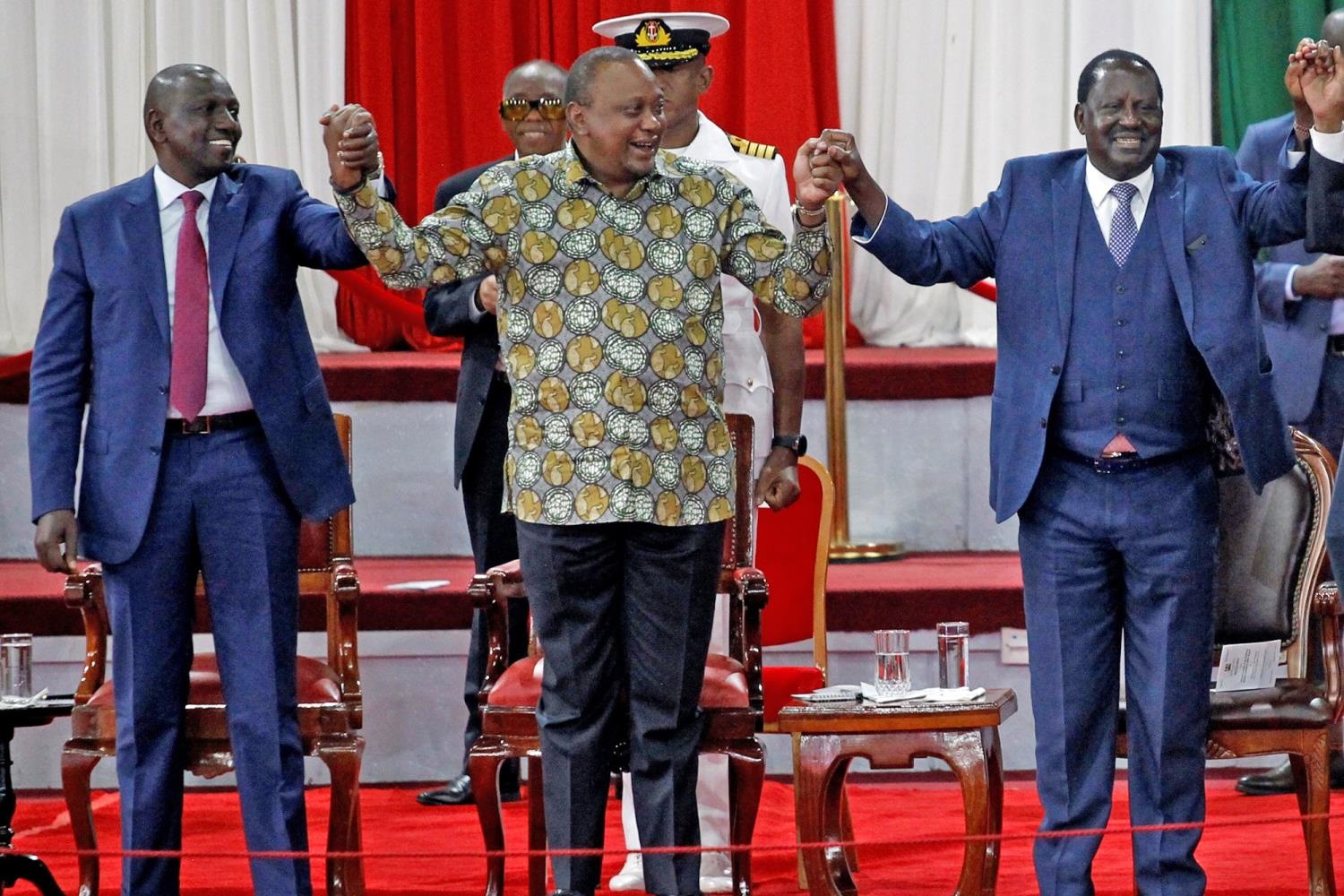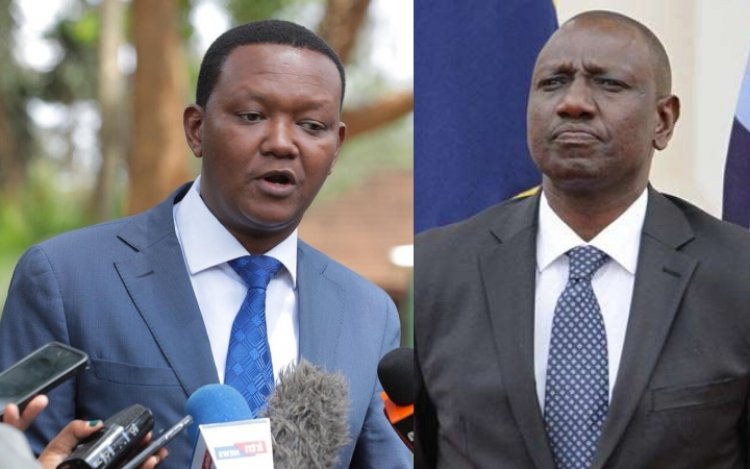Kenya’s political scene has always been marked with clashes and betrayals from one regime to the other.
Political betrayals and backstabbing in the country are something that began recently. It is something that has always existed all the way from independence.
Therefore, whatever is happening between President Uhuru Kenyatta and his deputy William Ruto is nothing new.
President Kenyatta and DP Ruto formed a coalition that took them to power in two consecutive elections, 2013 and 2017. But soon after the second election, the two top leaders began to collide hence causing political friction with the ruling party, Jubilee.
Kenyatta’s allies started blaming Ruto and his allies for undermining the President by conducting premature 2022 premature campaigns. On the other side, Ruto’s camp blamed Kenyatta’s side for working with their political rivals, ODM leader Raila Odinga to scuttle their man’s quest to clinch the country’s presidency.
The beginning of political betrayals
The first political betrayal began when Kenya’s first vice president, Jaramogi Oginga was put under house arrest after declining an offer from the British colony to be the country’s Prime Minister. According to Odinga, he could not be the country’s Prime Minister because Mzee Jomo Kenyatta “their already chosen leader” was still in prison.
Following Odinga’s stand, Kenyatta was released and become the country’s first President. Years later after Kenyatta and Odinga took the leadership of the country, they clashed over differences in ideologies. Their differences forced Kenyatta to throw Mr. Odinga into house arrest.
“Jaramogi, if you were not my friend, I would have crushed you like unga (maize flour),” Kenyatta would be recorded warning Jaramogi.
The consistent clash between the two leaders led to Jaramogi resigning from Kenyatta’s administration to become an opposition leader.
After Kenyatta’s betrayal to Odinga, subsequent leaders in the country have perfected that art, leaving behind a trail of broken promises and political frustrations in Kenya’s political scene.
Moi who become Kenyatta’s third Vice President braved humiliation from the country’s founding father to assume the presidency in 1978 with the support of then-Attorney General Charles Njonjo and Finance Minister Mwai Kibaki.
The three leaders united against a group of individuals who wanted to change the constitution to block MOi from succeeding the late President Kenyatta.
Fast forward, in 1984 President Moi sent Njonjo, his minister for Justice and Constitutional Affairs home.
Following his sacking, Njonjo would later refer to Moi as a ” passing cloud” to mean a stop-gap president, something that later kill his political career.
This brought to a stop the good days when Moi, Njonjo, and Minister GG Kariuki would ride on the same Presidential limo.
Kibaki was later demoted from his Vice President position to Health minister. He later abandoned Moi’s Kanu in 1991 at the advent of the multi-party democracy.
After the emergence of the multiparty system in the country also saw a series of betrayals in the country. Kenneth Matiba refused to support Jaramogi, his long-term ally for the presidency hence leading to the split of the Ford party.
The death of Jaramogi in 1994 saw his son, Raila Odinga, betray Michale Wamalwa who faithfully deputized the old man at the helm of Ford-Kenya.
Leadership wrangles within Ford-Kenya saw Raila leave the party to form National Development Party (NDP).
It was through NDP that Raila made his first attempt to be Kenya’s president but lost to Moi who took advantage of the divided opposition at the time.
Raila later joined Kanu through a coalition agreement with his party, NDP. The coalition saw Kanu diehards such as Prof George Saitoti, Moi’s then VP, and Kanu’s then secretary-general Joseph Kamotho thrown under the bus to accommodate Raila and his men.
Short-lived coalition
Following the changes in Kanu, Raila became the party’s secretary-general. The romance between Raila and Moi did not, however, last long after Moi chose Uhuru Kenyatta to be his preferred successor.
Raila then walked out of Kanu with some members including Prof Saitoti and formed Rainbow Alliance that later joined the National Alliance of Kenya that had Kibaki, Wamalwa, and Charity Ngilu. The two parties come together to form the National Rainbow Alliance (Narc).
But before Raila declare Kibaki to run for the presidency, former Cabinet Minister Simeon Nyachae had protested that Raila had first agreed to support him for the top seat. Raila years later confessed that he had betrayed the late Nyachae.
After forming the government with Kibaki as the president, Raila later cried foul after Baba Jimm trashed a power-sharing deal they had to allow him to become a prime minister in the Kibaki administration.
During the 2002 election campaigns, Raila did everything to see, Kibaki who was confined to a wheelchair following a road accident become Kenya’s third president.
Things, however, change for Raila as soon as Kibaki was confirmed as the president of Kenya. Reports claim that the morning after Kibaki was sworn in, Raila drove to State Hose to negotiate for Cabinet positions, but he was welcome by Kibaki’s men who told him that the president was not available.
The incident was the first indication that the pre-election agreement between Raila and Kibaki was thrown to the dogs, a sign of another political betrayal in the country.
The betray would then bring the likes of Raila, Ruto, Kalonzo, Uhuru, and other leaders together. The leaders came together to oppose Kibaki’s regime and its proposed constitutional amendment bill that was defeated in the 2005 referendum.
Following the defeat in the referendum, Kibaki sacked Raila his brigade from his cabinet. Raila and his colleagues would later former Orange Movement party to challenge Kibaki in the 2007 elections. Uhuru, however, abandoned the Orange and led Kanu to support Kibaki’s PNU.
The disputed polls that plunged the country into chaos saw Kalonzo, who decamped from Raila’s side join Kibaki and become his vice president.
To bring peace to the country, through mediation Kibaki and Raila agreed to form a coalition government with Kibaki. In the coalition government, Raila appointed Ruto as one of his ministers but later sacked him following a corruption scandal that touched his ministry.
Kibaki’s succession
The race to succeed President Kibaki saw Uhuru and Ruto reunite to compete Raila’s led coalition, Cord. Cord included political bigwigs such as Kalonzo, Raila, and Wetangula. At the time they were vying for election, Ruto and Uhuru were battling ICC cases which forced Uhuru to temporarily withdraw from the presidential race to throw his support to Musalia Mudavadi.
Uhuru and Ruto would later withdraw their support for Mr. Mudavadi with Uhuru claiming that he was misled to support Mudavadi for the top seat. Uhuru and Ruto could later win the elections beating Raila and his men.
Handshake betrayal
More recently, Raila’s colleagues in the Nasa coalition – Kalonzo, Mudavadi, and Moses Wetangula – accused him of betraying them by locking them out of the Handshake deal between him and President Uhuru Kenyatta even though they have been together in the last two successive elections.
On the other side, Raila’s men accused the trio of abandoning the former Prime Minister during his controversial swearing as the People’s President.



